By Donald H. Harrison

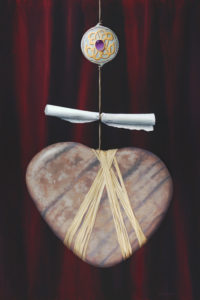
SAN CLEMENTE, California –Sometimes artists derive joy from hearing what you think their paintings are about versus what message they actually intended to impart. Paul Bond is one of those artists. I told him that while looking at online images of his art, I was struck by one titled “Sacred Contract #1.” As you can see from the reproduction at the right, dangling from a cord are a jewel, a rolled up piece of paper, and a stone heart wrapped in raffia.
Through my Jewish eyes, the symbolism seemed quite clear: The rolled up paper must have been a ketuba, the written contract a Jewish groom presents to his bride, who is the jewel of his eye. And while the heart represented their love, how easily it might turn to stone, particularly if one party put unwelcome restrictions on the other.
Although Bond believes that he may be descended on his mother’s side from Sephardic Jews, he grew up the son of an Episcopal priest and was unfamiliar with the word “ketuba.” The inspiration for this painting, in fact, came from a book authored by Carolyn Myss called Sacred Contracts. “It discusses how, prior to incarnation, we make contracts with ourselves and others to accomplish things in a given lifetime,” Bond writes in a collector’s book of his work called The Magic Realism of Paul Bond. “So, I added the scroll as a symbol of our contracts. The jewel represents our unique identity. The curtain background is the ‘stage’ of human experience. The heart stone, Love, holds it all in place and makes it all worthwhile.”
A “Sacred Contract” was not the culmination of Bond’s courtship of his wife, Donna Lupacchino; it was, in fact, the beginning. He confided to my grandson Shor and me that he met Donna on line. When she mentioned that she had been reading Myss’s book, he responded that he had as well, and in fact, had completed a painting on the theme of a sacred contract. He sent her a photograph of the painting.
They exchanged many more letters by email for an entire month before they met in person. Paul at that time was in the process of moving to Southern California from Santa Fe, New Mexico, where to support himself he had been buying homes, fixing them up and flipping them. “When I saw Donna she saw some paintings I had stashed away in the closet, and she literally said to me, ‘You can do that, and you are not doing that?’ I hadn’t painted much for three or four years, and it was a bit of a wake-up call for me. I wasn’t really fulfilled in my life.”
The artist said he and his wife had an interesting courtship. “We fell in love with each other before we met. It was beautiful. I came out a month later and met her, and I knew, this is the one.” Two weeks later, “she was having her 40th birthday party and I came back and I asked her to marry me. She said ‘of course.” It was just six weeks in, although we waited a year until we got married, as our parents were a little concerned — ‘Wait a second, you just met this guy on line, and he wants to move in with you and marry you?’ So, we waited a year before we got married, and we are married 10 years now.”
Donna was working as a marketer in the hospitality industry, with one of her clients being the Hotel del Coronado. She was doing well enough financially that she said to Paul, “Take whatever time you need on your art and develop it. Start painting again,” and so Paul phased out his real estate business, and devoted full time to his art. “Within a year I started showing at the Laguna Festival of the Arts, which literally made my career. There are about 3,000 people who go through there every night. There are 140 juried artists who vie to get in there every year. More people see my work than if I had a gallery.”
As Paul didn’t know the word “ketuba,” I figured correctly that he also might not be familiar with the word “beshert,” which is a Yiddish expression that often is used to connote the person who is intended for you. Paul was familiar with the concept, if not the word. As Donna had come to his aid, and permitted him to realize his potentiality, so too, approximately seven years later, was Paul, by then a successful artist, able to be the rock upon whom Donna could depend.
“About two or three years back, when she got her breast cancer, and she was looking at her career and her life, she said, ‘You know what, I have to get out of this business and do something different,’” Paul recalled. “At that point my art business was established, and I said, ‘Okay, leave your job, do some consulting,’ and she went back to school and got a master’s degree is spiritual psychology, which allowed her to move into this coaching practice.” So, as Donna was able to create “a space” for Paul, so too was Paul “able to create a space for her.”
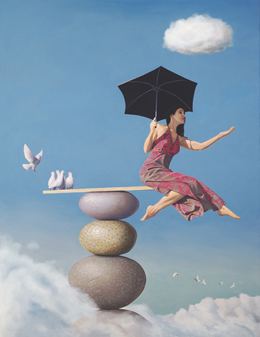
On display in a treasured spot in their San Clemente home is a painting Paul has titled “Mostly Sunny,” for which he used Donna as a model. Upon a cairn, a column of stacked boulders, that reaches high into the sky, is balanced a plank, upon which four doves nest on one side and Donna, holding a parasol, sits on the other side. Her right arm is outstretched as if testing the weather, which is mostly sunny. “This is how I see her—and she beautifully reflects a concept I cherish. That of living with a deep sense of grace. A knowing that we will never be placed in a situation, no matter how desperate it may feel at the time, without the means to come out of it a wiser and more evolved person.”
I asked Paul if he ever draws upon Hebrew Scriptures or the Bible for his images. He responded that the closest thing to that so far was a painting called the “Passage of the Wisdom Keeper.” In it, there is an “apple tree, representing the traditional wisdom of the Tree of Knowledge,” (Genesis 2:17) which is being pulled through the ocean by a kingfisher bird.
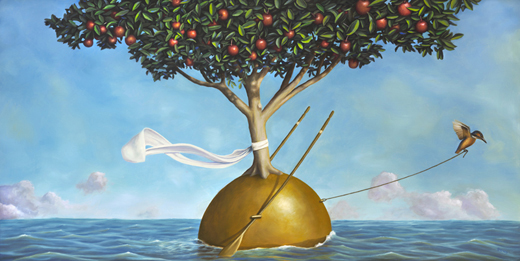
“The theme was the difference between knowledge and wisdom,” he said. “There are a lot of people out there with knowledge, especially in these times when you can access anything via the Internet. In 20 seconds, you can have an answer. You have the knowledge of it, but wisdom is something that you get through experience. Only through life experience do you get internal wisdom about something. Knowledge is a factoid, but wisdom carries us in a deeper way; it becomes part of the ship with which we are navigating our lives. So, the bird pulling the tree represents that life journey, how knowledge becomes wisdom.”
During our interview, Bond was seated in front of a painting that I asked if he would be so kind to explain.
“What often happens is that I’ll start with a scene, and it is almost like building blocks,” he said. “Sometimes I don’t know what the whole painting will look like, although very often I do have an idea in my head. Often times, I’ll see a scene, and I think, I like that. I will capture that in a photograph, or with a sketch, put it away, and later other pieces of that scene will come together and before I know it, I will have a painting. These stacked stones is a pretty common theme that I work with. The symbolism for me is that it represents the paradox of permanence and impermanence. Obviously, this (the cairn) could fall over at any point, but, then again, it has been there for a while. There is a huge tree that has been there for many years. It is how I view our own existence. We act like we are here permanently but at any point everything could shift. In the face of that, how do we keep our center? How do we stay balanced and how do we stay present, knowing that things could change at any moment?
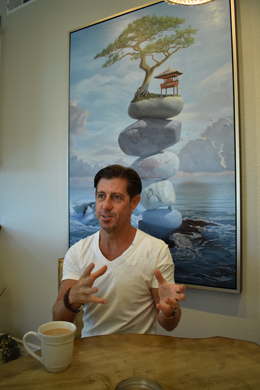
“The ocean represents that turmoil in life,” he continued. “How do we keep our center regardless of what is going on around us? I knew I wanted to do another painting on this theme and I went out to the beach, walked on some rocks, and got this photograph of the ocean. There is a beach near my house where I collect these stones and actually stack them up and take them out in the sun and photograph them, because I want to see how the light is falling, and get all the details of the rocks.
“As I started thinking about what else is going to go on around here, it started to evolve into a story about my experience with meditation. I started meditating about a year ago. Even though I had a spiritually rich life, I was never able to meditate. My mind was too active. I couldn’t still it. But I knew that was something that was important for me to find a way, even if it was just five minutes a day, or 10, 15, or 20. I meditate for 20 minutes, and it is almost like resetting your computer to clear the cache of cookies. Just reset, because there is so much noise. I heard about a practice called Transcendental Meditation from the times the Beatles went to India and met the Maharishi [Mahesh Yogi.] You get trained with someone who has been trained. They give you a word that is a mantra. It sounds like a Sanskrit word, but it actually has no meaning. In the course of a 20-minute meditation, you essentially repeat it. It is a little bit of self-hypnosis, but just in the repeating of this mantra, it gives you something other than your thoughts to focus on. So, I am able in that process to let go of the other thoughts.”
He added that “There is a phrase in meditation, which is called the ‘monkey mind.’ Like a monkey, our minds are constantly going, constantly chattering, and so [in the art work above], the monkey wearing a little crown has mastered his own monkey mind. He is sitting there in stillness and peace. The little building is from a photograph. I have a friend who lives in Bali, Indonesia. I go there often, so that is from a photograph I took of this temple.” The bonsai tree, he said, is a symbolic element of Zen Buddhism. “The title of this painting is ‘An Allegory On the Principles of Meditation,’ so again, it is about finding that still place, even for a few minutes a day that is vital for us to be able to reset our psyches and find our own center point.”
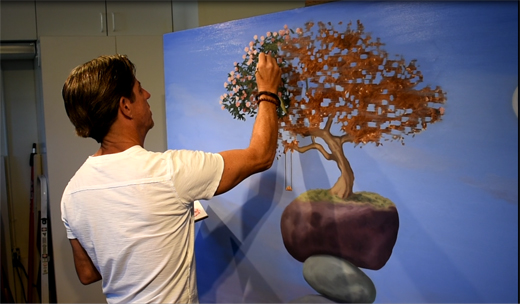
The genre in which Paul works is called “Magic Realism.” Would he please define it for us? “I like the term ‘Magic Realism” as opposed to ‘Surrealism,’ though I think they are interchangeable for the most part,” he answered. “Magic realism began as a term in literature, with a lot of those Latin American writers, like Gabriel García Márquez [Nobel prize winning novelist famous for One Hundred Years of Solitude]. As an art movement, you have a realistically rendered scene, first of all, and then you bring in elements of fantasy or dream-like scenery.”
“When I first studied art, I studied realism and I gravitated toward realism,” Paul continued. “I wanted to capture the essence of what I was seeing, but very early on I realized, well you can do that with a photograph, so what is the point in recreating something I could just photograph? I want to make it my own; what can I bring into it that gives it a different meaning, a different essence? But again, I am always striving to have things that look as realistic as possible because for me, one of the bottom lines of my art is that I am trying to recreate that dream state. We all dream in realism, at least everyone I know. You don’t dream in cartoon imagery. The more realistically I can render something, the more the subconscious doesn’t question it. … The more realistically I paint something, the more it draws people in. It lends credibility to the incredible!”
*
Harrison is editor of San Diego Jewish World. He may be contacted via donald.harrison@sdjewishworld.com Masori, who participated in the interview, is a staff photographer for San Diego Jewish World. He may be contacted via shor.masori@sdjewishworld.com
Dear Mr. Harrison, Thank you for your beautiful capture of our story. My eyes well with your beautiful depiction of our magical life. Thank you for sharing this with your readers!